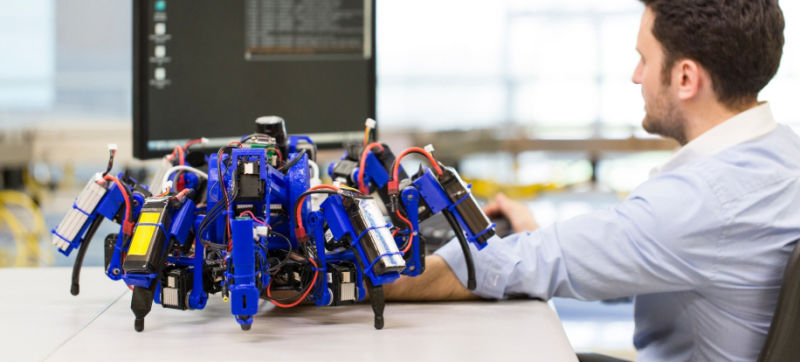Siemens Spiders Weave a Web with 3D Printing

This spider bot may end up being the 3D printing’s new best friend. Courtesy of Siemens.
Latest News
April 25, 2016
Most people’s first reaction upon seeing a spider (including my wife) is to squash it, particularly if it happens to be spinning its webs in your living room. Regardless of its oft-cited contribution to cutting down on more obnoxious insects, such as mosquitos, folks just can’t seem to bring themselves to love something that scuttles along on more than four legs. Even common nursery rhymes encourage spider drowning as a reasonable response to eight-legged encounters.
A research team based at Siemens Corporate Technology’s Princeton campus is having none of that. Rather than reviling spiders, the team has taken inspiration from their determination to keep on building, no matter how many times someone knocks down a web with a broom. A new breed of robotic spiders combines tenacity, teamwork and 3D printing as means on conquering large-scale printing projects.
 This spider bot may end up being the 3D printing’s new best friend. Courtesy of Siemens.
This spider bot may end up being the 3D printing’s new best friend. Courtesy of Siemens.Developed entirely in-house, the robotic spiders, called SiSpis, are equipped with small fused deposition modeling (FDM) extruders spinning PLA thermoplastic. Along with the extruder, each spider is equipped with a camera and laser scanner that assist in determining their exact location in space.
Unlike actual spiders, SiSpis work in teams, each running a version of Siemen’s NX PLM software. The software directs the swarm as a whole, breaking down the task of large-scale printing projects into smaller chunks that are built in tandem. In theory, SiSpis could be used to print auto bodies, ship hulls, airplane wings, and other such large jobs without requiring an oversized 3D printer.
Each spider is self-monitoring, and uses its location detection abilities to return to a charger when its batteries begin to run low. Upon docking, the spider not only starts the recharge process, it also uploads a progress report on how much of a build it has completed, allowing fresh bots to take its place and begin work where it left off.
None of that may increase the general public’s appreciation for spiders, but it does represent an alternative to the bigger-is-better approach being taken by many 3D printing researchers. A company could purchase SiSpis in lots according to its needs, rather than sinking funding into one large system. That could lead to increased opportunities for smaller businesses, or offer the option of breaking up the swarm to work on several different projects at the same time.
Below I bring you a video of spiders in all their glory.
Source: Gizmodo
Subscribe to our FREE magazine, FREE email newsletters or both!
Latest News
About the Author
John NewmanJohn Newman is a Digital Engineering contributor who focuses on 3D printing. Contact him via [email protected] and read his posts on Rapid Ready Technology.
Follow DE





